PLALEAVES, Your Premium Biodegradable Mulch Film Manufacturer in China
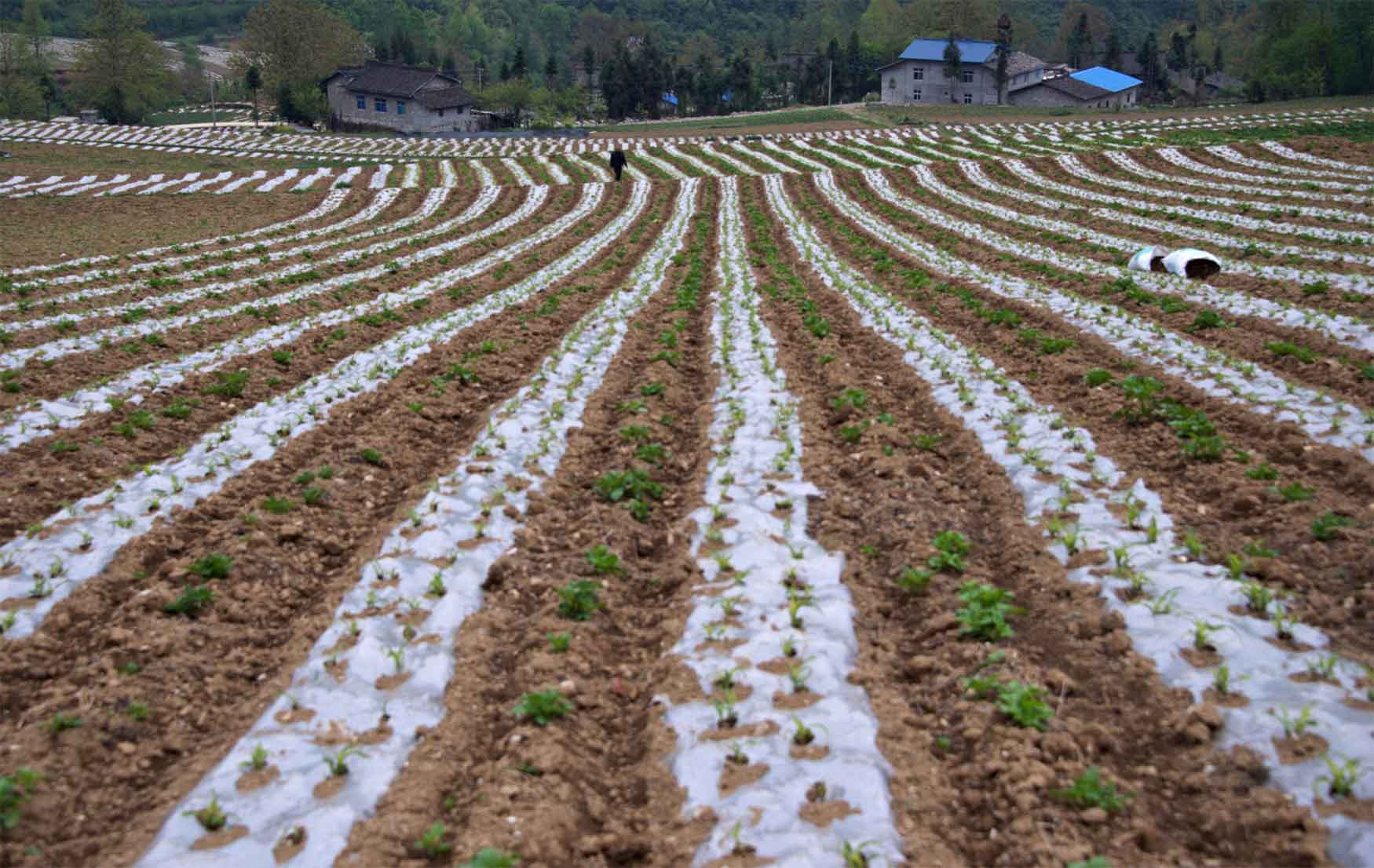
Problems of plastic conventional agricultural mulch film is gradually emerging:
1. The increasing pollution of residual agricultural mulch film: most of the agricultural mulch film material used is plastic, agricultural plastic mulch film is not degradable in soil residual film, and the agriculture plastic mulch film is extremely thin, it is difficult to recycle, gradually accumulate in the fields of plastic agricultural mulch film. Even with recycling, there is the recovery of high cost, low recovery, the recovered films are difficult to process using secondary pollution problems.
2. Cause soil compaction: agricultural plastic mulch residual soil impede capillary penetration of water and natural water, soil moisture, reduce soil permeability, soil microbial activity and soil fertility.
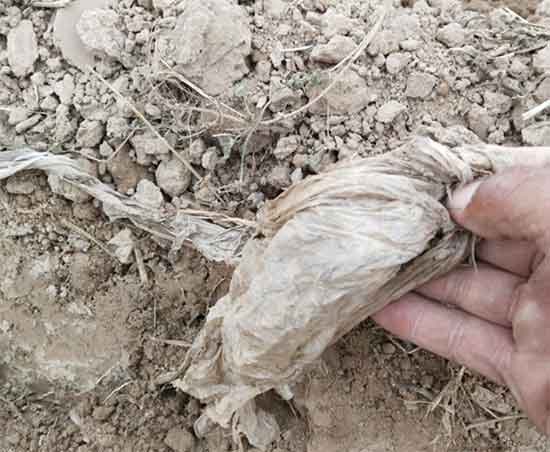
3. Agriculture plastic film resulting in cuts, studies have shown that the average residual amount reached 77.9 kg per hectare, 167.6 kg per hectare, 279 kg per hectare, 372 kg per hectare, When cotton yield is respectively reduced by 3.82%, 7.42%, 11.7% and 18.92 %.
4. Agriculture plastic film fragments may cause crop straw and fodder mixed together, after eating cattle and sheep and other livestock adverse gastrointestinal function or even death affect the comprehensive utilization of straw.
5. The flying plastic mulch film, environmental landscape, resulting in "visual pollution" and so on.
Investigation of the residual amount of agricultural mulch film in soil (Chinese Academy of Agricultural Sciences) :
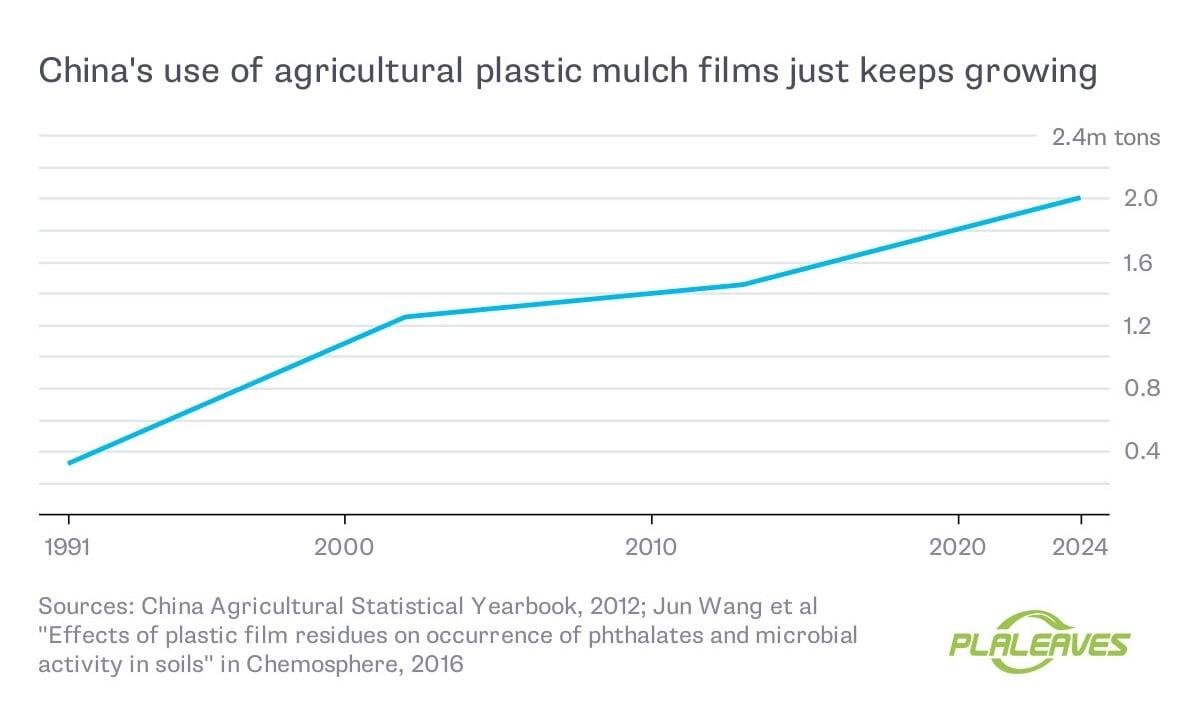
Area | Overed years | Mulch film input (Kg/ hectare) | Farmland coverage ratio,(%) | Film thickness (μm) | Film width (cm) | Residual amount of mulch film (kg/ hectare) |
Chengan, Hebei | 10 | 33 | 46.4 | 4-6 | 90 | 80.5 |
Shihezi, Xinjiang | 20 | 61.4 | 84.8 | 6-8 | 205 | 208.5 |
Tongchuan, Shanxi | 15 | 39 | 81 | 6-8 | 70/80 | 110.2 |
Zhengning, Gansu | 15 | 75 | 90 | 8 | 120 | 136.7 |
Enshi, Hubei | 10 | 52.5 | 53.15 | 6-8 | 90 | 71.9 |
Date only in China cities
The influence of residual Agriculture plastic mulch film on soil quality:
Residual Quantity (kg/100m2) | Water content (%) | Bulk density ( g/m3) | Relative density | Porosity (%) |
0 | 16.2 | 1.21 | 2.58 | 53.0 |
0.375 | 15.5 | 1.24 | 2.60 | 52.4 |
0.75 | 15.9 | 1.29 | 2.61 | 50.5 |
1.5 | 14.7 | 1.36 | 2.65 | 48.6 |
2.25 | 14.3 | 1.43 | 2.63 | 45.7 |
3.0 | 14.5 | 1.54 | 2.67 | 42.3 |
3.75 | 14.4 | 1.62 | 2.66 | 39.2 |
4.5 | 14.2 | 1.84 | 2.70 | 35.7 |
It can be seen that as the amount of residual film in the soil agriculture plastic mulch increases, the soil moisture content decreases, the void ratio decreases, the density increases, and the soil gradually hardens.
What are we going to do?
The Best Solution - PLALEAVES Biodegradable Mulch Film
The final degradation products of PLALEAVES biodegradable mulch film are water and CO2, which can effectively solve the residual film pollution problem of plastic mulch film, and does not need to be recycled. In theory, using biodegradable mulch film is the best shortcut to solve mulch film pollution.
The role and advantages of PLALEAVES biodegradable plastic mulch:
1. Insulation and warming: Generally speaking, compared with no mulching in agriculture in winter and spring, the soil temperature of 5~10 cm can increase by 2~4℃.
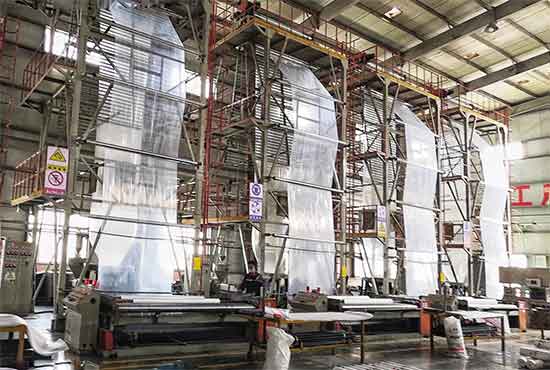
2. Inhibition of surface water evaporation: Biodegradable plastic mulch film can reduce water loss due to soil evaporation. Related experiments show that the soil moisture content of 0-20 cm in 70 days after mulching is 1.6% to 2.4% higher than that of open land, which is equivalent to 6.5 mm of water.
3. Inhibition of weeds: PLALEAVES biodegradable mulch film can inhibit the growth of weeds. Generally, the biodegradable plastic mulch can reduce weeds by 1/3 compared with the non-mulching film. In particular, the biodegradable agriculture black mulch film has an obvious weed control effect. Biodegradable plastic mulch can greatly reduce the use of herbicides.
4. Other functions: PLALEAVES biodegradable plastic mulch film reduces the loss and volatilization of fertilizers in the soil, prevents soil compaction, promotes plant development, and reduces pests and diseases.
All in all, the PLALEAVES plastic mulch biodegradable film makes full use of limited light, heat, water and nutrient resources to promote seed germination and crop growth. It is an active "root-promoting cultivation" method.
5. Reduce the consumption of fossil energy, fundamentally solve the problem of recycling of waste agricultural plastic film, and eliminate white pollution in farmland. In the long run, the PLALEAVES fully biodegradable paper mulch is more suitable for the needs of modern agricultural development.
The importance of mulching in agriculture by PLALEAVES biodegradable agriculture mulch:
1. Advance the planting date of crops to obtain early maturity and increase yield. The crop matures 5-20 days earlier, and the yield generally increases by 30%-50%.
2. Expand the planting area, move the planting area 3 to 5 latitudes north, and expand agricultural production to cold areas, high altitude areas, and arid areas.
3. Reduce white pollution, reduce the use of petroleum-based products, and reduce recycling costs.
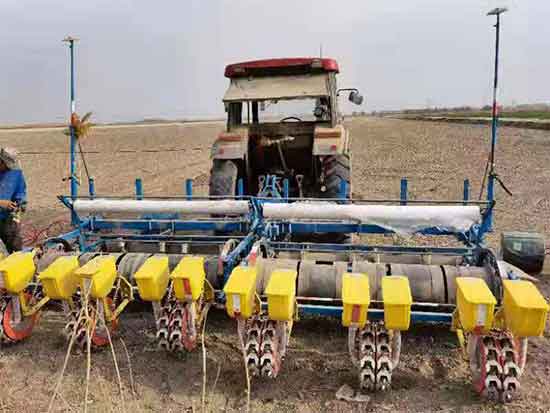

Problems that may be encountered in the use of biodegradable mulch film, and PLALEAVES's solution.
Problems that biodegradable mulch film may encounter 1:
The complexity of application conditions bring about degradation controllability problems, which are mainly manifested in the following aspects:
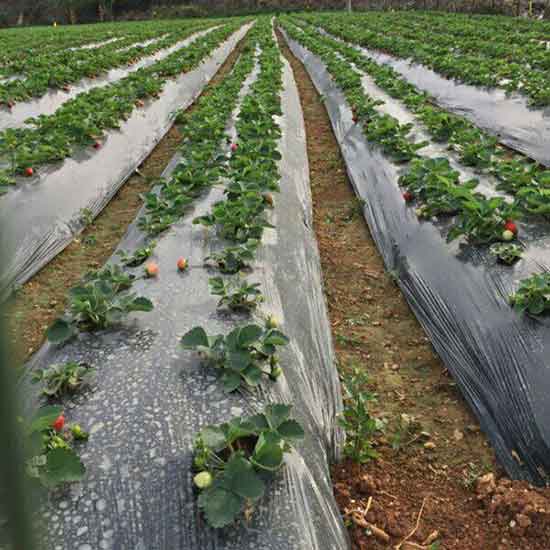
PLALEAVES biodegradable mulching sheet solves this problem:
1. Accumulate field experiment data under different climatic conditions, and make targeted designs for mulch film production prescriptions.
2. Develop special biodegradable mulching sheets for different crops (such as cotton farm mulch, tobacco farm mulch, beans farm mulch).
Making the biodegradable mulch film achieve controllable degradation is the place that best reflects the technical level of PLALEAVES biodegradable mulch film, PLALEAVES can be one of your best biodegradable agricultural mulch film suppliers.
Problems that biodegradable mulch film may encounter 2:
The long induction period of crop growth and rapid biodegradation after use, quickly realize the next season's planting:
The induction period of degradable mulch film refers to the event from the moment the biodegradable mulch paper is laid to the beginning of cracking on the surface of the film. During the induction period, keeping the surface of the mulch film intact can effectively maintain the heat preservation and moisture preservation function of the mulch film. After the mulching paper is cracked, the heat preservation and moisture preservation function will gradually decrease. If the induction period is too short to meet the required "safe cover time" of the crop, it will affect the growth of the crop. Resulting in reduced production or even no harvest.
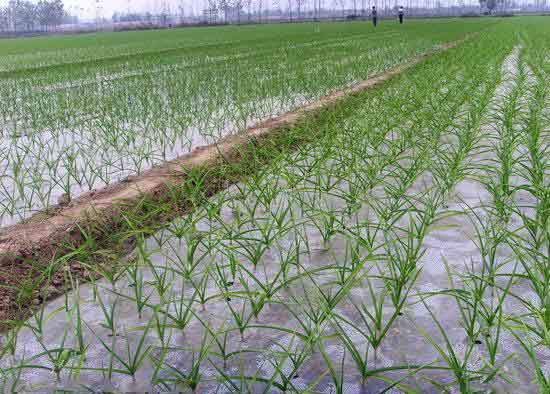
In most areas, the safety coverage time required for most crops is more than 90 days. The induction period of most biodegradable sheet mulching is about 30 to 70 days, and the risk of premature use of the bio mulch film rupture is high.
Safe coverage time required by different crops. |
|
Crops | Safety overlay time |
Cotton | 120-150days |
Corn | ≈90days |
Potato | ≈90days |
Peanut | Over 70 days |
Tobacco | Different regions,50~90days |
Vegetable | 30-90days(over summer),150days(over winter) |
The new agriculture mulching paper material designed by PLALEAVES obtains a biodegradable mulch film with an induction period of more than 150 days, and realizes the induction period, which can be adjusted freely within a certain time range (70~180 days).
Problems that biodegradable mulch film may encounter 3:
The water vapor transmission rate of the biodegradable mulch film is too high and requires special modification:
The traditional mulching film is PE, the biodegradable mulching film is polyester, is biodegradable due to the difference in molecular structure, the water vapor transmission at the bottom is relatively high, and the effect of water retention and heat preservation is relatively poor. When used in arid areas, it has a greater influential impact when needs to be biodegradable, the biodegradable agriculture mulching sheet need to be treated for water retention.
We use the cup method to measure the water vapor transmission rate of 6 μm PE at 200g/m2 for about 24 hours, and the water vapor transmission rate of the 10 μm unmodified PBAT membrane at 3000g/m2 for about 24 hours. The difference is obvious.
PLALEAVES The designed new biodegradable agriculture mulch film material, through the way of water vapor:
Name | Thickness, μm | Water vapor transmission rate, g/(m2d) |
Normal Bio-mulch film | 10 | ~3000 |
PLALEAVES mulch film | 10 | 300~350 |
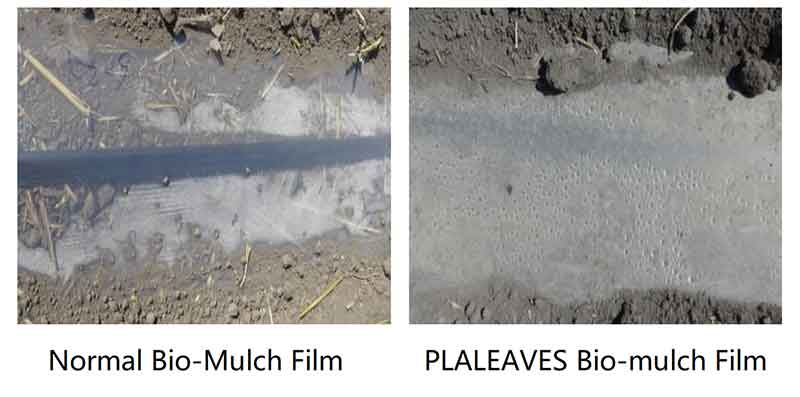
The water vapor transmission rate is 300-350 g/(m2d), which is close to PE and has a higher water retention rate than other biodegradable agricultural mulches. So in arid areas or mountainous areas with difficult irrigation, the soil can achieve better moisture retention. In addition, a good water retention rate can achieve a better insulation effect. So collectively referred to as heat preservation and entropy preservation.
Problems that biodegradable mulch film may encounter 4:
The cost of biodegradable agri mulch is little higher:
1. Due to the higher price of the basic materials of biodegradable agricultural mulching in farming, it is about 2 to 3 times different from traditional mulching paper for agriculture.
2. The material density of biodegradable agricultural mulch is higher than plastic mulch film agriculture, the density of low-density PE is 0.92, and the density of biodegradable material PBAT is about 1.23.
Using the same thickness of film to cover the same area, biodegradable mulch sheet is 30%~35% more weight than PE mulching sheet for agriculture.
How to comprehensively consider the high cost of biodegradable mulch film?
1. Technical level: Thinning the biodegradable mulch can reduce the film cost of the biodegradable mulch.
Conventional PE mulch has different regulations in different countries, and many countries stipulate that the thickness of conventional mulch shall not be less than 10μm. The PLALEAVES biodegradable mulch film is not limited by the thickness, and can be 6μm, 5μm or even 4μm, which can meet the requirements of use, which will make up for the difference in price and density (without sacrificing performance).
2. Comprehensive consideration, the cost of the film used in the whole cycle: traditional mulching film has recycling costs, post-processing costs, PLALEAVES biodegradable mulching film does not have these costs.
3. Environmental cost: Traditional PE film will cause irreparable damage to the environment. PLALEAVES biodegradable plastic for farming has an inestimable contribution to the cost savings in environmental protection.
The main performance test results of PLALEAVES biodegradable agricultural mulch film:
Test item | Technical indicators | Test results |
Tensile load, Horizontal/Vertical, N | ≥2.00/≥2.00 | 2.66/2.13 |
Nominal strain at break, Horizontal /Vertical,% | ≥150/≥250 | 647/941 |
Right angle tear load, Horizontal /Vertical,N | ≥0.80/≥0.80 | 1.10/0.83 |
Water vapor transmission,g/(m2d) | <800 | 339 |
Heavy metal content, (As), mg/kg | ≤5 | 0.443 |
Heavy metal content, (Cd), mg/kg | ≤0.5 | 0.324 |
Heavy metal content, (Cu), mg/kg | ≤50 | <0.02 |
Heavy metal content, (Pb), mg/kg | ≤50 | 4.01 |
Heavy metal content, (Hg), mg/kg | ≤0.5 | <0.0003 |
Heavy metal content, (Ni), mg/kg | ≤25 | 7.48 |
Heavy metal content, (Se), mg/kg | ≤0.75 | 0.285 |
Heavy metal content, (Zn), mg/kg | ≤150 | <0.02 |
Heavy metal content, (Cr), mg/kg | ≤50 | 0.638 |
Heavy metal content, (Mo), mg/kg | ≤1 | 0.646 |
Heavy metal content, (F), mg/kg | ≤100 | 9.11 |
Heavy metal content, (Co), mg/kg | ≤38 | <0.0005 |
Organic composition, % | ≥51 | 99.0 |
Relative biodegradability, (180d), % | ≥90 | ≥98.1 |
The technical indicators are based on the current national standards for agricultural mulch film in China.
All technical indicators of PLALEAVES biodegradable agricultural mulch are in line with China's existing national standards for biodegradable mulch film market.
Precautions for the use of PLALEAVES biodegradable agricultural mulch:
1. Different regions and different crops need to choose the biodegradable mulch roll with the different degradation time.
2. The requirements of crops on the color, width, and roll weight of the mulch film need to be stated.
3. Special purpose biodegradable paper mulch roll needs to be communicated and customized in advance.
4. Sharp tools such as iron hooks should not be used during transportation, loading and unloading, and no throwing need special agricultural mulchers for covering.
5. For transportation and temporary storage, no exposure to sunlight or rain, no mixed shipment with sand, broken metal, coal, glass, etc., and no mixed packing with toxic, corrosive or flammable materials.
6. When covering the film, the soil shall be fine and level, avoid touching stones and other sharp objects under the film, and stretching is strictly prohibited. Sharp objects are easy to scratch the surface of the film, resulting in weakening of the warming and moisture-preserving effect of the mulching sheet farming, which affects the effect of use.
7. It is recommended to use it correctly under the guidance of relevant technical personnel.
8. The residual part of this product in the soil after the crops of the current season is harvested is a normal phenomenon and does not affect the planting of the next season's crops. At this time, the tensile force of the mulch film has dropped significantly, and it can continue to degrade after entering the soil after rotary tillage.
9. Please strictly follow the product certification and the markings on the packaging bag to prevent counterfeiting.
Storage environment and period of PLALEAVES agricultural mulch
1. Generally 5 kg packaging, the machine can cover more than 20 kg.
2. This product needs to be stored in a ventilated, cool and dry warehouse, away from fire, try not to squeeze, prevent direct sunlight, and do not stack it in the open air. The temperature during transportation and storage must not exceed 50 degrees Celsius.
3. The shelf life is one year, use as soon as possible after opening the bag, and do not expose it to the air for a long time.
A large number of field experiments on PLALEAVES agricultural mulch (partial)
Through years of field planting mulching farming, we have made detailed records of the planting results of different regions, different climate characteristics, and different crops, accumulated rich experience, and made corresponding formula adjustments according to the improvement needs of farmers.
Color | Degradation time | Crops | Planting Time | Inside or outside the shed | Location |
Black color | 6 months | Summer squash | December | Inside the shed | Yangyuan County, Zhangjiakou City, Hebei Province |
Black color | 6 months | Blueberry | December | Inside the shed | Suizhong County, Liaoning Province |
Black color | 6 months | Tomato | Early April | Both | Shanxi Province |
Black color | 4 months | Broccoli | Early March | Outside the shed | Shanxi Province |
Black and white color | 4 months | Corn, sorghum | Early April | Outside the shed | Datong City, Shanxi Province |
Black color | 4 months | Watermelon, sugar cane, pepper | Around March 10th | Inside the shed | Heze City, Shandong Province |
Black color | 4 months | Cucumber | November | Inside the shed | Wafangdian city, Liaoning Province |
Black or white color | 4 months | Pepper | April 10th | Outside the shed | Sichuan Province |
Black and white color | 4 months | Tomato | November | Inside the shed | Wafangdian city, Liaoning Province |
Black color | 3-4 months | Tobacco | April | Outside the shed | Shaanxi Province |
Black color | 3 months | Towel gourd | April | Inside the shed | Weifang City, Shandong Province |
Black color | 3 months | Pepper | Early April | Outside the shed | Yongkang City, Zhejiang Province |
Black color | 2 months | Lettuce | Early March | Outside the shed | Guanghan City, Sichuan Province |
Black color | 2-3 months | Tomatoes, cucumbers | July | Inside the shed | Wafangdian City, Liaoning Province |
Black color | 2-3 months | Cherry | April | Outside the shed | Wafangdian City, Liaoning Province |
Black color | 2-3 months | Potato, sweet potato | Late April | Outside the shed | Tianjin Province |
Black or white color | 6 months | Corn | End of March | Outside the shed | Longxi County, Dingxi, Gansu Province |
Black or white color | 6 months | Potato | End of March | Outside the shed | Longxi County, Dingxi, Gansu Province |
Black or white color | 6 months | Chinese medicinal materials | End of March | Outside the shed | Longxi County, Dingxi, Gansu Province |
White color | 3 months | Watermelon | December | Inside the shed | Yanan City, Shaanxi Province |
White color | 3 months | Muskmelon | December | Inside the shed | Yanan City, Shaanxi Province |
White color | 3 months | Pepper, eggplant | December | Inside the shed | Yanan City, Shaanxi Province |
White color | 2 months(1 roll) 4 months(1 roll) | Chili | Around April 5th | Outside the shed | Shanxi Province |
White color | 3 months | Ginger | Early April | Inside the shed | Shandong Province |
White color | 4 months | Potato | Middle of March | Outside the shed | Weifang City, Shandong Province |
White color | 6 months | Cotton | Middle of April | Outside the shed | Aksu City, Xinjiang Province |
White color | 6 months | Cotton | Before April 10th | Outside the shed | Xinjiang Province |
The data mainly comes from our field trials in the Chinese cities.
The types of mulching in agriculture from biodegradable agricultural mulch supplier- PLALEAVES:
From the appearance, PLALEAVES mulch can be divided into the following categories:
1. White transparent mulch film with obvious warming effect.
2. Single color mulching film (black, green, silver gray), biodegradable black plastic mulch, which is black weedblock biodegradable mulch, has better weeding effect.
3. Double-sided heterochromatic composite mulch (black/white, silver/white, silver/black).
4. Color-matched mulching film (black/white) with multiple strips of mulching film: both warming and weeding.
The types of mulch films PLALEAVES has commercialized:
Biodegradable mulch film in greenhouse in winter for strawberry
Biodegradable agricultural paper mulch for sweet potato
Biodegradable agricultural paper mulch for tobacco
Biodegradable agricultural paper mulch for corns
Biodegradable plastic mulching in vegetables
Biodegradable plastic mulching in organic farming for potato
Biodegradable mulch film for peanut
Biodegradable plastic mulching in agriculture for rice
Biodegradable plastic mulch for summer squash
Biodegradable plastic mulch for blueberry
Biodegradable plastic mulching in vegetables
Biodegradable plastic mulch for tomato
Biodegradable plastic mulch for broccoli
Biodegradable plastic mulch for sorghum
Biodegradable mulch roll for watermelon
Biodegradable mulch roll for sugarcane
Biodegradable mulch roll for pepper
Biodegradable mulch paper for loofah
Biodegradable mulch paper for cherry
Biodegradable paper mulch for traditional Chinese medicine
Biodegradable paper mulch for muskmelon
Biodegradable paper mulch for cotton
Biodegradable agricultural paper mulching in organic farming
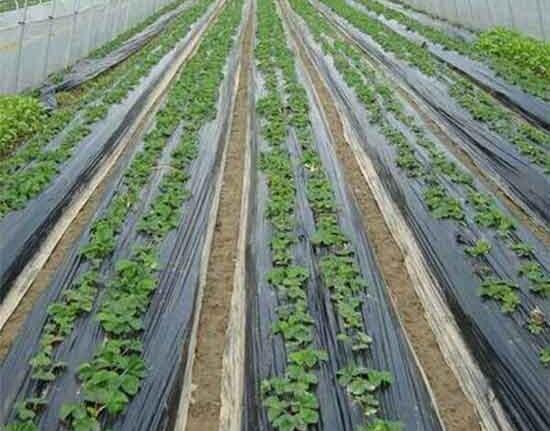
Choose PLALEAVES to be Your #1 Biodegradable Agricultural Mulch Film Supplier in China
Field Trial case sharing:
PLALEAVES biodegradable mulch film testing report 1 (Corn Planting):
From 2018 to 2019, in order to achieve green development of agriculture, improve white pollution, and increase crop yields, PLALEAVES' compostable mulch film was used in corn planting in Twelve Liancheng Township, Zhungeer Banner, Ordos City, Inner Mongolia.
First. Basic information
Twelve Liancheng and Rural Areas are the northernmost part of Zhungeer Banner, on the south bank of the Yellow River, on the northern edge of the Kurqi Desert. It is adjacent to the New District of the Mainland and Dalu Town to the east, Burthao Sumu to the south, Jigestai Town of Daqi to the west, and Tumet Right Banner and Tuoketuo County across the river to the north. The climate type is a mid-temperate continental climate, with an average temperature of 7.3°C, a frost-free period of 150 to 180 days,
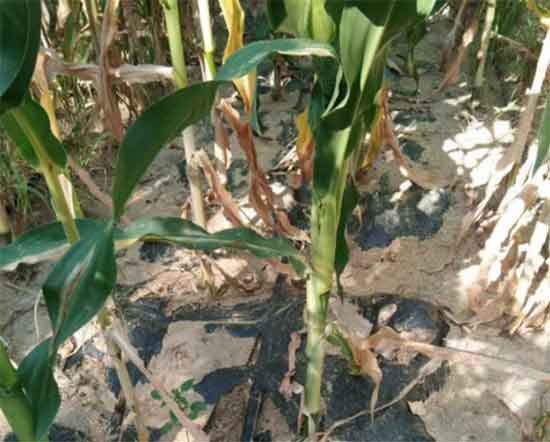
a sunshine speed of 3119 hours, an effective accumulated temperature of ≥10°C of 3350°C, and an average annual precipitation of 350mm. Through preliminary investigation and selection, more than 95% of it was degraded into carbon dioxide and water within the required time. After a small batch test of 0.33 hectare, the effect was as expected. It was decided to lay 13.33 hectares of corn planting in batches in order to better collect data and promote.
Index measurement and analysis:
1. The effect of biodegradable mulching film on soil temperature:
Through the data analysis of the monitoring points during the experiment, it is found that the temperature of 5-20 cm of the soil with mulching film is 3-6℃ higher than that without biodegradable mulching film.
2. The effect of biodegradable plastic mulch on soil moisture content:
Through experimental data, it is found that the water content of the soil with mulching film is 2%~5% higher than that of the soil without biodegradable mulching film.
3. The effect of biodegradable agricultural mulch film on seedling emergence:
With the increase of soil temperature and water content, the emergence rate of the land using the biodegradable agricultural mulch is 5% higher than that of the land without the biodegradable agricultural mulch.
4. The impact of biodegradable mulch film on yield:
Through this experiment, the use of biodegradable mulch film has improved the yield of corn compared with the use of PE film and bare land. The specific values are shown in the table below.
Second. The growth of crops
As an agricultural product, the corn used a width of 1000 mm and a thickness of 10 μm. The black fully degradable mulch film and the conventional PE film were laid at the same time and the corn was sown, and then covered with the film. The mulching film was penetrated and grown after emergence. Fully degraded by weighing, the average yield of mulching film is 650kg/0.06 hectare, the average yield of ordinary film is 550 kg/0.06 hectare, and the average yield of bare land is 500 kg/0.06 hectare。
Corn Yield Records in Zhungeer Banner, Ordos City
Unit:kg
Date | Bio bio mulch film 0.33 hectare | PE mulch film 0.33 hectare | Bare land 0.33 hectare |
Setp.25th | 3250 | 2750 | 2500 |
Total | 3250 | 2750 | 2500 |
Increase from bare land | 750 | 550 | 0 |
Increase from bare land | 750(30%) | 750(30%) | 750(30%) |
Increase from PE mulch | 500(18.2%) | 500(18.2%) | 500(18.2%) |
Degradation of PLALEAVES biodegradable mulch film:
After 30 days of laying, the biodegradable film becomes soft. After 60 days, there is cracking on the surface of the film. About 5% of the film is degraded. After 90 days, more than 50% of the mulch is degraded, and 90% of the film is degraded when the corn is harvested.
Summary:
1. Judging from the pyrolysis and degradation of the field film, the PLALEAVES biodegradable mulch film begins to pyrolyze and degrade in about 60 days, and enters the rapid pyrolysis and degradation in 80-90 days, and the degradation degree exceeds 90% when crops are harvested.
2. It is concluded from the test data that the PLALEAVES biodegradable film has a certain influence on temperature and humidity, can better keep crops warm and moisturize, and has a positive effect on crop growth.
3. The PLALEAVES black biodegradable weed fabric has fewer weeds than the PE black mulch film.
4. Judging from the output data, the PLALEAVES biodegradable mulch film has a significant effect on increasing the yield of corn, which is more effective than conventional PE.
5. According to relevant data, the use area can be expanded in the future.
PLALEAVES biodegradable mulch film testing report 2(Melon planting):
With the gradual improvement of agricultural production and scientific cultivation of crops, plastic film mulching, as an important technical measure to make full use of natural resources such as temperature, light, soil, and water, increase crop yields and improve crop quality, is deeply loved by farmers, etc. Since most of the materials we use are PE or PVC, they degrade very slowly and accumulate in the soil for a long time, which will cause the permeability of the soil to decrease, the growth of crop roots will be blocked, the absorption of water and fertilizer will not be smooth, and it will continue to release toxic substances during the long degradation process. Harmful substances affect the quality of crops. In the spring of 2019, we introduced PLALEAVES biodegradable mulch film for fruit and vegetable production and conducted field experiments. The aim is to confirm the application effect of biodegradable mulch film in fruit and vegetable production through experiments.
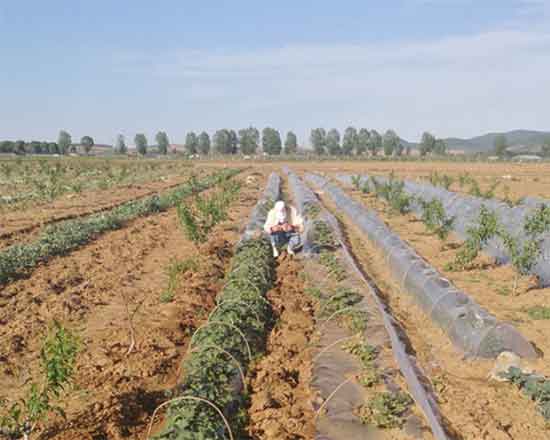
Materials and Method:
1.1 Experimental materials:
Experimental mulch: PLALEAVES biodegradable agricultural mulch, the specification is 0.008mm, and the degradation time is 120 days
Compare mulching film: PVC black mulching film, the specification is 0.004mm.
Experimental crop: melon, the variety is “Improved Flower Girl”.
Planting method: open-air planting.
1.2 Experimental method
Test location: Qianyuan Village, Yuantai Town, Wafangdian City
Test time: April 20th, 2019, with an average daily temperature of 17℃, which is a suitable planting temperature.
Test site conditions: The test site is soil with medium fertility, and the irrigation mode is micro spraying.
Experimental design: The experimental treatment adopts large-area comparison without repetition, and each treatment is 80m2. The experiment site was turned over a year ago, and on April 18th, 0.5 cubic meters of soil and miscellaneous fertilizers, 5 kg of potassium sulfate compound fertilizer (15-15-15), and rotary tillage was applied to each plot. Planting on April 20th, the row spacing is 50 cm, the hole spacing is 20 cm, and the film is covered directly after the planting on April 20th.
Results and Analysis
2.1 Degradation effect
The first investigation was set about two months after planting, and the degradation was investigated in the field. The second survey time was set at about four months after planting, and the degradation and the growth of field crops were investigated in the field. The third survey was set at about 6 months after planting, and the degree of degradation was investigated in the field. The survey results are as follows:
2.2 Investigation of the biological characteristics of plants
2.2.1 Comparison of fruiting time
The first time for ordinary mulch to sit on melon is May 30th.
PLALEAVES fully degradable mulch, the first time to sit on the melon is on May 23, scrape the ordinary mulch about 7 days in advance.
2.2.2 Impact on the growth traits, yield and quality of melon.
Two months after planting, 5 points were randomly selected from each group, and one fruit was selected from each point, and the weight, sweetness and maturity were compared.
Crop Natural Traits Survey Form
Mulch type |
| Single fruit weight(g) | Sugar content(%) | Maturity |
Normal mulch | 1 | 301.8 | 13.5 | Mature |
Normal mulch | 2 | 397.4 | 8.5 | Immature |
Normal mulch | 3 | 243.2 | 11 | Immature |
Normal mulch | 4 | 275 | 10.5 | Immature |
Normal mulch | 5 | 268.5 | 10.6 | Mature |
Normal mulch | Average | 297.18 | 10.82 | - |
PLALEAVES biodegradable mulch firm | 1 | 398.9 | 12.9 | Mature |
PLALEAVES biodegradable mulch firm | 2 | 250.3 | 12.5 | Mature |
PLALEAVES biodegradable mulch firm | 3 | 283.4 | 12.5 | Mature |
PLALEAVES biodegradable mulch firm | 4 | 284 | 14 | Mature |
PLALEAVES biodegradable mulch firm | 5 | 340 | 13.6 | Mature |
PLALEAVES biodegradable mulch firm | Average | 311.32 | 13.1 | -Mature |
It can be seen from this table that the PLALEAVE biodegradable mulch film can effectively increase the yield of melons, the weight of individual fruits can increase by about 5%, and the sweetness of them can be increased by about 20%. The ripeness of melons grown with ordinary mulches is poor, and the yield can basically increase by 15%.
3. In conclusion
Through the experiment of PLALEAVES biodegradable mulch film, in the case of open field experimental application, the ripening speed, sugar content and weight of melon can be increased to a certain extent, which can achieve the purpose of promoting ripening and increasing production and income. According to the investigation results of field production experiments, PLALEAVES fully degradable mulch film can reach 60% degradation rate in 6 months in crop fields, and has a tendency to continue to degrade. Compared with ordinary organic mulch film, there is no degradation and no degradation trend.
FAQ
Get your best quote
Q:What information you need to custom your own PLALELAVES biodegradable mulch film?
A:1.Tell us your location, so we can get the basic information like the longitude, latitude, altitude of your location, temperature, light, rainfall of your location.
2. Tell us the name of the crop you want to plant.
3.Tell us whether it is inside or outside the shed?
4.Tell us what month you started planting and what month you started harvesting.
5.How many seasons do you need to plant a year?
6.Tell us the fertility of your soil.
Then our technicians will customize your own PLALEAVES biodegradable mulch film based on the information you provide.
Q: How to prove that your product is suitable for our use?
A: After you provide us with all the information, our technicians will design a mulch that meets your needs, as agricultural production is a long-term process, there are a lot of uncertainties, our suggestion is carry out small batch planting, and decide whether to carry out large batch planting or adjust the design through the results of the small batch.
Q: What are the advantages of using mulch film applications?
A: Mulch films rank third in terms of the number of plastics used in agriculture. Mulch films made with conventional polyethylene are typically burned, buried, stockpiled, or tossed in landfills. None of these disposal methods are sustainable and do not alleviate the problem of plastics in the environment.
However, mulch films made with PLALEAVES biodegradable technology degrade oxidatively and when ploughed into soil after harvest, they biodegrade in the presence of oxygen and micro-organisms into carbon dioxide, water and biomass.
PLALEAVES mulch films help growers/farmers reduce plastics waste generation while capitalizing on its benefits such as the reduced need for pesticides, minimized need for irrigation, and maximized crop yields.
Q: What are the benefits of biodegradable mulch for farmers?
A: Increase soil temperature
Speed up the germination and cultivation cycles
Long-term nutritious soil
Cost and labor efficient
Eliminate or reduce the use of herbicides and pesticides
Reduce water consumption
Keep fertilizers and nutrients closer to the plant
Prevent fruits & vegetables from direct contact with the soil
Q: Will the biodegradable mulch films leave behind any toxic residue if they are left in soil after harvest?
A: PLALEAVES biodegradable mulch films have been used in the fields for many years with no incidence of bio-toxicity or reduced soil fertility. PLALEAVES biodegradable mulch films have undergone rigorous eco-toxicity testing and found to be non-toxic in soil after harvest.

